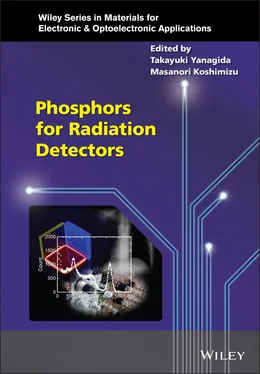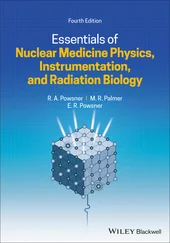Phosphors for Radiation Detectors
Здесь есть возможность читать онлайн «Phosphors for Radiation Detectors» — ознакомительный отрывок электронной книги совершенно бесплатно, а после прочтения отрывка купить полную версию. В некоторых случаях можно слушать аудио, скачать через торрент в формате fb2 и присутствует краткое содержание. Жанр: unrecognised, на английском языке. Описание произведения, (предисловие) а так же отзывы посетителей доступны на портале библиотеки ЛибКат.
- Название:Phosphors for Radiation Detectors
- Автор:
- Жанр:
- Год:неизвестен
- ISBN:нет данных
- Рейтинг книги:3 / 5. Голосов: 1
-
Избранное:Добавить в избранное
- Отзывы:
-
Ваша оценка:
- 60
- 1
- 2
- 3
- 4
- 5
Phosphors for Radiation Detectors: краткое содержание, описание и аннотация
Предлагаем к чтению аннотацию, описание, краткое содержание или предисловие (зависит от того, что написал сам автор книги «Phosphors for Radiation Detectors»). Если вы не нашли необходимую информацию о книге — напишите в комментариях, мы постараемся отыскать её.
Phosphors for Radiation Detectors
Discover a comprehensive overview of luminescence phosphors for radiation detection Phosphors for Radiation Detection,
Phosphors for Radiation Detection
Phosphors for Radiation Detection
Phosphors for Radiation Detectors — читать онлайн ознакомительный отрывок
Ниже представлен текст книги, разбитый по страницам. Система сохранения места последней прочитанной страницы, позволяет с удобством читать онлайн бесплатно книгу «Phosphors for Radiation Detectors», без необходимости каждый раз заново искать на чём Вы остановились. Поставьте закладку, и сможете в любой момент перейти на страницу, на которой закончили чтение.
Интервал:
Закладка:

Figure 1.7 Relationship between the scintillation decay time (ns) and emission wavelength (nm).
In some specific applications, a very fast response is required, and in such a case, timing resolution is important. The timing resolution is not a physical property of each material but a detector property depending on properties of detector components, including scintillators, photodetectors, and readout electronics. Although there is no clear numerical function form, the timing resolution is a function of scintillation light yield, rise, and decay times. In order to achieve a high timing resolution, fast rise and decay times accompanied with a high light yield are required. In addition, fast rise and decay times of photodetector are also required. The recent timing resolution is ~100 ps [69], and in time‐of‐flight positron emission tomography (TOF‐PET), 100 ps timing resolution corresponds, for example, to 3 cm localization limitation of a tumor.
The other important property of the scintillation detector is an afterglow, which mainly affects integration‐type detectors such as X‐ray CT and security systems. If the afterglow is huge, the S/N and spatial resolution in the radiation image degrade. Because the main target is the human body, X‐ray CT requires very low afterglow levels for scintillators, and typical afterglow levels are few, at the ppm level. Among commercial scintillators, BGO and CdWO 4are known to show very low afterglow levels, and GOS also shows a relatively low afterglow level. Taking into account the balance of light yield and afterglow, most X‐ray CT use GOS as a main device. In security systems, Tl‐doped CsI is widely used, since it shows a high emission intensity with very low cost, although the afterglow level is the poorest among these commercial scintillators. Physically, the afterglow is TSL at room temperature, and scintillators for integration‐type detector should not have TSL glow peaks below 100 °C. On the other hand, except for very huge afterglow, photon counting‐type detectors can ignore the afterglow because it generally appears as a very small pulse with a high frequency, and is generally cut by lower threshold level of the electronics. Details of TSL is described in Chapter 7, and is a scientifically interesting topic deeply related to afterglow in long persistent luminescence for night illuminations [70].
1.3.5 Radiation Hardness
Some applications use a huge amount of irradiation of ionizing radiation, and to employ detectors in such an environment, radiation hardness (or radiation tolerance) is required. Ionizing radiations can cause ejections and ionizations of atoms. When we irradiate high energy photons, such as X‐ and γ‐rays, ionization is a main phenomenon, and energetic particles mainly cause an ejection. In the case of e −, p, and n, if their energy exceeds a threshold energy, generation of the Frenkel defect, which consists of hole and interstitial ion, starts. In such ejection‐induced damage, generation of defects will occur, and will reduce scintillation light yield by trapping.
The most typical radiation damage is a degradation of transmittance, and coloration is often observed. If the transmittance decreases, emitted photons inside the scintillator cannot reach the photodetectors, and cause a reduction of signal output intensity from the photodetectors. In the case of PbWO 4, which is often used for experiments in high energy physics, p‐irradiation with ~10 5Gy causes a degradation of transmittance which induces a reduction of light yield [71]. When the coloration occurs due to exposure of ionizing radiation, it sometimes recovers by annealing (thermal annealing, thermal bleaching), UV‐irradiation (UV‐annealing), and keeping the sample under room temperature for a long time (spontaneous recovery). In typical interpretation, ejected ions stay near to the incident position, and by these perturbations of thermal or light energy, they can return to the incident position. On the other hand, damage by hadron beams are not or less recovered by these phenomena. It can be understood that the amount of damage is largely higher than that generated by X‐ or γ‐rays.
There are several ways of evaluating the effects of radiation damage; one of the typical ways is to measure optical transmittance before ( T 0( λ )) and after T ( λ ) of the irradiation. By using the thickness of the sample d , the relationship before and after irradiation is
(1.26) 
where μ iris an irradiation‐induced absorption coefficient. By this μ ir, we can evaluate the radiation damage quantitatively. In actual experiments of radiation hardness, after the irradiation, many small signals can be detected if you directly observe the output signal of scintillator + photodetector by oscilloscope, and these small signals are the afterglow induced by a huge amount of irradiation.
One of the relating phenomena is positive hysteresis (sometimes called radiation drift), which is a phenomenon in which the light yield of the scintillator is increased after exposure to ionizing radiation. From the viewpoint of solid‐state physics, it is an interesting phenomenon, but from the engineering and operation of actual detectors, it is problematic because it causes a temporal change of the detector gain. The positive hysteresis was discovered in Tl‐doped CsI [72] and Ce‐doped GSO [73, 74]. After these pioneering works, we found Ce/Zr co‐doped GSO [75] and Ce‐doped GAGG [76] also exhibited the positive hysteresis. Up to now, several interpretations are proposed, and our interpretation is a generation of tentative excitation states [75, 76].
1.3.6 Temperature Dependence
As with other phosphors, scintillators show temperature dependence, especially on light yield and timing properties. When we consider the temperature dependence, population of excited states for luminescence and trap states and thermal quenching should be considered. The populations of excited states depend on the thermal vibration of the lattice, so if we increase the temperature, the light yield shows the highest value at the optimum temperature while the decay time decreases monotonically. The same is also true for trap states which deeply relate to TSL described in Section 1.4and Chapter 7. If the environmental temperature for the sample is enough to excite trapped electrons to the bottom of the conduction band, trapped electrons can be released immediately after trapping, and contribute to scintillation. In this case, the scintillation light yield appears to have an optimum temperature. This phenomenon is called thermal activation. Thermal quenching is common for all the phosphors, and generally, higher light yield can be achieved at lower temperatures due to the suppression of thermal loss. In common thermal quenching, light yield and decay time decrease with the increase in temperature.
In most practical detectors, the operating guaranteed temperature is from −30 to 40 °C, but detectors in some special applications, such as oil‐logging and monitoring the area around nuclear reactors, must work at several hundreds of °C. The temperature dependence of scintillators and photodetectors cannot be avoided, and we generally correct it with an analysis method or control the temperature by hard (cooling instrument). If we wish to measure the temperature dependence of the scintillator as in solid‐state physics, it would be better to measure it by an X‐ray induced radioluminescence spectrum because only the sample is cooled in this experiment. On the other hand, if we wish to measure the temperature dependence as a radiation detector, the device module (scintillator + photodetector) should be measured ([77]).
Читать дальшеИнтервал:
Закладка:
Похожие книги на «Phosphors for Radiation Detectors»
Представляем Вашему вниманию похожие книги на «Phosphors for Radiation Detectors» списком для выбора. Мы отобрали схожую по названию и смыслу литературу в надежде предоставить читателям больше вариантов отыскать новые, интересные, ещё непрочитанные произведения.
Обсуждение, отзывы о книге «Phosphors for Radiation Detectors» и просто собственные мнения читателей. Оставьте ваши комментарии, напишите, что Вы думаете о произведении, его смысле или главных героях. Укажите что конкретно понравилось, а что нет, и почему Вы так считаете.












